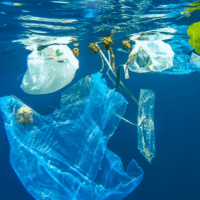The proposed ban list includes only six items that have already largely fallen out of favour. These are low-hanging fruit: Opinion:Kim Elmslie and Ashley Wallis
Canada’s aspirational vision of zero plastic waste by 2030 is one to be celebrated, but the federal government’s proposed ban on single-use plastic items is far from what is needed to address the plastic disaster that is choking our oceans.
Shockingly, single-use plastics make up nearly half of Canada’s plastic waste. These items — created for a few seconds’ use — can persist in our oceans for centuries, disfiguring, suffocating and strangling marine animals.
But the federal government’s proposed ban list includes only six single-use plastic items that have already largely fallen out of favour: Checkout bags, straws, stir sticks, six-pack rings, cutlery and polystyrene takeout containers. These are low-hanging fruit. Several municipalities and provinces have already banned plastic checkout bags. Most major fast-food chains have already turned their back on plastic straws in favour of paper.
Jonathan Wilkinson, minister of the environment and climate change, acknowledges what an insufficient contribution the ban will have towards realizing zero plastic waste by 2030, stating in a recent interview that the list only represents a “fraction … of one per cent” of the plastic products we use.
Instead, he points to other proposed policy measures, like extended producer responsibility (making companies pay for and operate recycling systems) and recycled content requirements as the keys to ending plastic pollution.
These are useful parts of the puzzle, but the government’s proposed approach is overly reliant on recycling as a silver-bullet solution to the crisis — a familiar and dangerous narrative, given that less than nine per cent of all plastic waste has actually been recycled.
Recycling alone won’t get Canada anywhere near zero plastic waste by 2030, even with innovation in the recycling sector — especially when you consider that plastic use is expected to increase by 30 per cent over the next decade.
Only by reducing plastic production and use and improving collection and recycling would we have a fighting chance of reducing plastic pollution.
When your bathtub is overflowing, you turn off the tap before you reach for a mop. Canada needs to commit to reducing plastic production and use, including a more comprehensive approach to banning single-use plastics.
There are a number of plastic products that Canada needs to ban if it wants to join the ranks of global leaders, items that have already been banned in other jurisdictions, including plastic-stemmed cotton swabs, cartons for eggs, produce and fruit, and lightweight produce bags. Items that are like those on the list but have been excluded, including hot and cold drink cups and lids. Materials that are known to be exceptionally harmful to the environment or human health, including oxo-degradable plastics, and all forms of polystyrene.
Canada is a major contributor to plastic pollution. Per capita, Canada uses nine times more plastic than India and almost four times as much as some Southeast Asian countries.
If we are serious about showing leadership, we must back our aspirational goals with a realistic plan informed by science with time-bound targets and goals. A plan where reduction and reuse are the main act, and recycling plays a supporting role.
We need a plan that details a clear path to zero plastic waste by 2030. The current plan won’t get us there.
Add your voice and call on the Canadian government to expand the ban list and stop the flow of unnecessary, single-use plastics into our oceans.
Kim Elmslie is the campaign director and Ashley Wallis is the plastic campaigner for Oceana Canada.
Originally published in The Province.
MOST RECENT
March 6, 2025
February 3, 2025
January 22, 2025
Celebrating New Beginnings in 2025: Four Right Whale Calves Spotted Off Florida Coast

